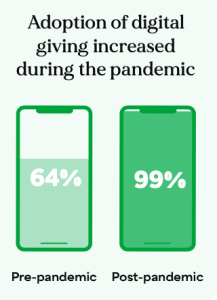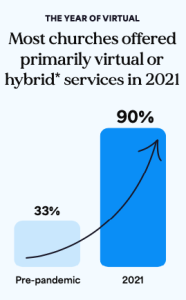The financial hardships many Americans faced during the COVID-19 pandemic did not result in the predicted revenue declines for U.S. churches, according to new research into congregational giving trends.
In fact, the study conducted by the Lake Institute on Faith and Giving and the online giving platform Givelify found that consistent teaching about giving and the proliferation of virtual worship during the coronavirus outbreak actually boosted tithing among church members even when they struggled to make ends meet.
“Many people experienced financial uncertainty during the pandemic, yet they provided incredibly generous support toward their places of worship. A majority (84%) of givers reported that they maintained or increased their giving to their places of worship in 2021,” according to the 2022 “Giving in Faith” study. “This is a trend we observed within the faith community who use Givelify: Total charitable giving grew 174% between 2019 and 2021.”
 The report added that “77% of faith leaders reported that giving to their congregations increased or remained the same in 2021, which reflects giving to congregations reported in other national studies. Among the primary reasons faith givers financially support their places of worship are: religious conviction (65%), the worship experience (37%), and a desire to compensate the place of worship for opportunities it provides them (26%).”
The report added that “77% of faith leaders reported that giving to their congregations increased or remained the same in 2021, which reflects giving to congregations reported in other national studies. Among the primary reasons faith givers financially support their places of worship are: religious conviction (65%), the worship experience (37%), and a desire to compensate the place of worship for opportunities it provides them (26%).”
Givers also maintained or increased church contributions out of gratitude for the spiritual strength provided by the congregations and ministers, said Juana Véliz, director of brand marketing for Givelify.
“They wanted to do good and give back, and at the same time … they were moved by their faith and by the work being done in their community,” she reported. “In the 2020 report and in comments we get from current users of our app, there was a feeling of being blessed and grateful.”
Expanded options paid off
The expansion of online offerings during the pandemic also paid off for congregations in terms of engagement, the survey found. “As more leaders began to offer virtual worship, congregations that adopted digital solutions saw their attendance numbers recover. While some studies reported declining rates of attendance in 2021, our study found that, during the same timeframe, 66% of organizations that adopted digital worship or giving reported an increased or steady rate of attendance.”
Congregations that adopted digital solutions saw their attendance numbers recover.
Churches that offered virtual options often enjoyed greater member loyalty as a result. “Most individuals (91%) reported that they did not change affiliation from their primary place of worship during the pandemic, finding solace in their spiritual family and leader.”
The report said 90% of faith leaders reported offering online services in 2021, mostly through live streaming with some degree of audience interaction. It also found that “84% of organizations will continue to provide virtual services, with another 13% reporting that they will likely continue to offer a virtual component to their services.”
The report also uncovered a correlation between the availability of online services and maintenance or increase in giving, Véliz said. “One in five individuals are giving to multiple places of worship. It’s part of engagement. Churches are not just getting support from current members, but also from others who are visiting in this hybrid and digital space.”
Role of faith leaders important
The role of religious leaders also was found to be crucial to continued and expanded giving during the pandemic, when 51% of givers experienced a loss of income and 67% saw an increase in household expenses.
“Faith leaders were the driving force inspiring people to give back to communities instead of pulling back in times of uncertainty,” Véliz said.
Many givers said they were attracted to churches where the importance of giving was strongly and regularly emphasized.
Many givers said they were attracted to churches where the importance of giving was strongly and regularly emphasized. Among religious leaders surveyed, 40% said they teach about the religious mandate to give and 94% said they teach about giving at some point during the year.
Strong clergy leadership in other areas of religious life also influenced giving, the report added: “The primary factor that drew givers in this study to their chosen place of worship is the faith leader. The faith leader’s ability to reinforce the religious conviction to give, craft the worship experience and champion community outreach is the unifying factor that inspires their members to give generously.”
 It also was important to givers that their churches minister to surrounding communities during the pandemic, the study found. Almost all (97%) expected their congregations to provide some form of local outreach and more than 90% of churches reported doing so.
It also was important to givers that their churches minister to surrounding communities during the pandemic, the study found. Almost all (97%) expected their congregations to provide some form of local outreach and more than 90% of churches reported doing so.
“Faith leaders were pivotal in driving this community outreach: 82% reported that the desire of leadership to support causes in the community resulted in the increase in outreach during the pandemic,” the survey found.
“Givers want to be benevolent, and they expect their congregations to be an extension of their generosity within their communities. Likewise, faith leaders are not only deeply committed to the communities they serve, but they are beacons of light who champion new outreach.”
Changes are here to stay
Now, American churches must accept the fact that virtual worship and new attitudes and patterns toward giving are here to stay, the report concluded. “The COVID-19 pandemic has fundamentally changed how we interact with organizations and people, and it has accelerated the integration of digital tools into our day-to-day lives. These societal shifts, combined with the accessibility of virtual worship services, have also influenced how givers want to engage with their places of worship.”
More than 70% of givers said they attended their places of worship virtually in 2021 and 59% said virtual attendance is an acceptable way of belonging to their religious communities. Neary all religious leaders (97%) told researchers they intend to continue virtual or hybrid offerings that emerged during the pandemic.
Congregations that embraced digital during the pandemic fared much better than those that didn’t.
The benefits are clear. Congregations that embraced digital during the pandemic fared much better than those that didn’t, according to the study. In 2020, churches with a digital presence received 533% more in donations than those without that presence.
“We see this shift reflected in the behavior of faith givers who turned to digital giving during the pandemic,” the researchers said. “Almost all givers (92%) intend to continue using online and mobile giving options to give to their places of worship, continuing the trend we uncovered in our 2020 report.”
Related articles:
Charitable giving bounces back in 2021 but more for secular than sacred causes
Against the odds, the SBC is experiencing a double-digit increase in giving
In second year of pandemic uncertainty, church leaders are watching year-end giving closely


